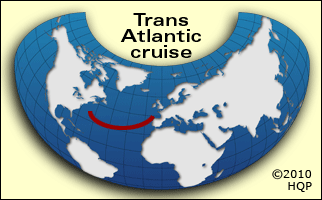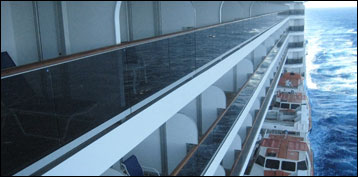Transatlantic
 Top 3 essentials about
TransAtlantic cruises to
know before you book
Top 3 essentials about
TransAtlantic cruises to
know before you book1. The difference between repositioning and regularly scheduled TransAtlantic cruises
Both are one-way. You cruise cruise going and fly back - or do the reverse. Here's how the two cruise types compare:
-
Repositioning
TransAtlantic cruise
This is the most popular type. Essentially, a ship crosses the Atlantic twice a year to be where the best weather is - and, therefore, where cruisers vacation.
Spring - March, April or May.
Ships relocate from the Americas (especially the Caribbean) to Europe (usually the Mediterranean).
Fall - September, October or November.
Ships reverse their nautical migration by returning to their winter habitat.
Most repositioning voyages last about two weeks because their itineraries include several stops. These can be during the ocean crossing or directly after it.
To entice travelers to book repositioning cruises, lines offer enticingly low fares, and many travelers grab them.
- Scheduled
TransAtlantic cruise
The Cunard Line is the dominant player in this category. Its Queen Mary2 ping-pongs between New York and Southampton from May to October
The voyage takes only six days because the Queen Mary2 does not make stops along the way, And, the stylish Queen Mary2 is 50% faster than the typical trans-ocean cruise ship.
Cruisers will like this itinerary if they relish relaxing, get-away-from-it-all sea days. You don't see land for four consecutive days. Cruisers also appreciate the low-keyed traditional style.
The good news is the North Atlantic is typically smooth sailing from April to October. The bad news is occasionally this ocean becomes stormy with gale-force winds, heavy downpours, and huge waves.
The good news is the North Atlantic is typically smooth sailing from April to October. The bad news is occasionally this ocean becomes stormy with gale-force winds, heavy downpours, and huge waves.
But you can significantly increase the odds in your favor by knowing the following:
- Northern vs southern route
The northern route (such as New York to England) is more prone to bad weather than the southern one (such as Florida to the Mediterranean). And the Northern route can be too cold for using the pool in the spring.
- Type of ship
Larger and newer ships are usually designed to handle rough seas.
Sailing west (Europe to the Americas) is superior to cruising eastbound. Consider:
- 25-hour days
You get an extra hour to enjoy the ship each day the captain adjusts the ship's clock forward. Heading eastbound, you would have 23-hour days.
- Jet lag
If you sail westbound, you would fly from the Americas to Europe - and those flights are typically night ones. This makes it easier for you to sleep on the plane and, therefore, reduce the jetlag effect.
 More tips
TransAtlantic
tips & insights
More tips
TransAtlantic
tips & insightsWhy a TransAtlantic cruise is special
You relive the Golden Age of cruising - the first half of the 20th century. Passenger ships ruled the Atlantic and trans-ocean flights barely existed.
Airline ticket issue
TransAtlantic cruises are one way. Therefore, you will need a one-way air ticket to return home. Be aware that most airlines charge almost as much (if not more) for a one-way as for a round trip ticket. This is a deal breaker for many would-be TransAtlantic cruisers.
Who should not take a TransAtlantic cruise
Don't go if you: • Are prone to motion sickness. • Feel uneasy about not seeing land for days. • Are far more interested in shore excursions than relaxing sea days. • Crave a party ship.
Onboard activities and facilities
It's difficult to be bored. Take your pick: Broadway-style shows, musical combos, comedians, piano bars, movies, dancing, lounges, casinos, restaurants, buffets, outdoor barbecues, lectures, cooking lessons, wine tastings, reading, games, demonstrations, boutique shopping, spa treatments, jogging, swimming, sunbathing, and relaxing doing absolutely nothing.
Destinations
TransAtlantic cruise ships collectively visit ports in these and other countries: Bermuda, Brazil, Canada, Canary Islands, Caribbean Islands, England, France, Iceland, Ireland, Italy, Madeira, Spain, and the USA.
Luxury cruises
There are more sea days, fewer ports of call on a TransAtlantic cruise. This increases the appeal of a luxury cruise because you'll be spending more time onboard. Luxury ships have larger cabins, uncrowded public spaces, superior dining experiences, better lectures, fewer PA interruptions, to name but a few of many benefits.


